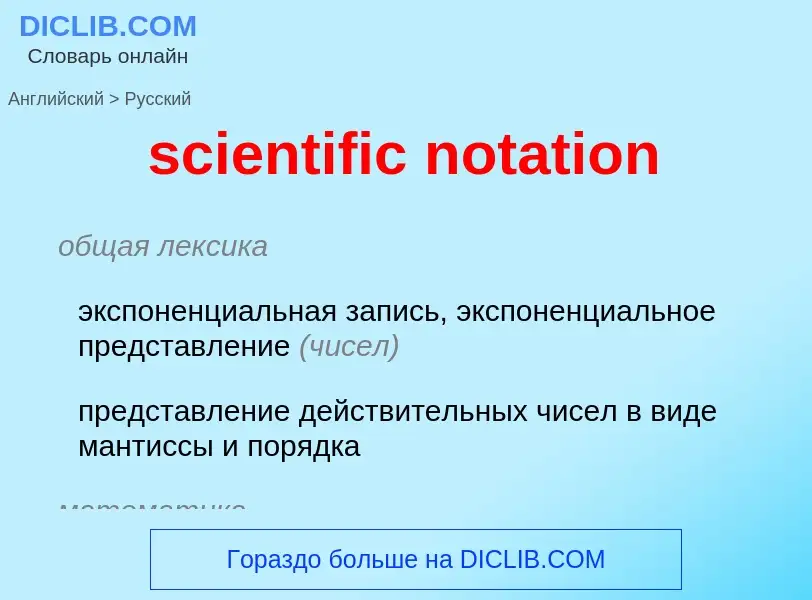Перевод и анализ слов искусственным интеллектом ChatGPT
На этой странице Вы можете получить подробный анализ слова или словосочетания, произведенный с помощью лучшей на сегодняшний день технологии искусственного интеллекта:
- как употребляется слово
- частота употребления
- используется оно чаще в устной или письменной речи
- варианты перевода слова
- примеры употребления (несколько фраз с переводом)
- этимология
scientific notation - перевод на русский
общая лексика
экспоненциальная запись, экспоненциальное представление (чисел)
представление действительных чисел в виде мантиссы и порядка
математика
экспоненциальное представление (чисел)
математика
экспоненциальное представление (чисел)
математика
логарифмическое представление
вычислительная техника
форма записи чисел с плавающей точкой
математика
префиксный оператор
общая лексика
нотная запись
общая лексика
префиксная нотация, польская [бесскобочная] запись
одна из возможных бесскобочных форм записи арифметических выражений, функций и их операндов, в которой имя функции предшествует всем её операндам. В этой нотации выражение (A+B)?C будет записано как ?+ABC
синоним
Смотрите также
общая лексика
бесскобочная система обозначений
бесскобочная запись
бесскобочное обозначение
Определение
Википедия
Scientific notation is a way of expressing numbers that are too large or too small to be conveniently written in decimal form, since to do so would require writing out an unusually long string of digits. It may be referred to as scientific form or standard index form, or standard form in the United Kingdom. This base ten notation is commonly used by scientists, mathematicians, and engineers, in part because it can simplify certain arithmetic operations. On scientific calculators it is usually known as "SCI" display mode.
In scientific notation, nonzero numbers are written in the form
or m times ten raised to the power of n, where n is an integer, and the coefficient m is a nonzero real number (usually between 1 and 10 in absolute value, and nearly always written as a terminating decimal). The integer n is called the exponent and the real number m is called the significand or mantissa. The term "mantissa" can be ambiguous where logarithms are involved, because it is also the traditional name of the fractional part of the common logarithm. If the number is negative then a minus sign precedes m, as in ordinary decimal notation. In normalized notation, the exponent is chosen so that the absolute value (modulus) of the significand m is at least 1 but less than 10.
Decimal floating point is a computer arithmetic system closely related to scientific notation.


![[[Amazing Grace]] in numbered notation. [[Amazing Grace]] in numbered notation.](https://commons.wikimedia.org/wiki/Special:FilePath/AmazingGraceNumberedMusicalNotation.png?width=200)



![A photograph of the original stone at Delphi containing the second of the two [[Delphic Hymns]] to [[Apollo]]. The music notation is the line of occasional symbols ''above'' the main, uninterrupted line of Greek lettering. A photograph of the original stone at Delphi containing the second of the two [[Delphic Hymns]] to [[Apollo]]. The music notation is the line of occasional symbols ''above'' the main, uninterrupted line of Greek lettering.](https://commons.wikimedia.org/wiki/Special:FilePath/Delphichymn.jpg?width=200)
![Music notation from an early 14th-century English [[Missal]] Music notation from an early 14th-century English [[Missal]]](https://commons.wikimedia.org/wiki/Special:FilePath/Head of Christ1.jpg?width=200)
![A tablet with the Hymn to Nikkal inscribed<ref>Giorgio Buccellati, "[http://128.97.6.202/urkeshpublic/music.htm Hurrian Music]", associate editor and webmaster Federico A. Buccellati Urkesh website (n.p.: IIMAS, 2003).</ref> A tablet with the Hymn to Nikkal inscribed<ref>Giorgio Buccellati, "[http://128.97.6.202/urkeshpublic/music.htm Hurrian Music]", associate editor and webmaster Federico A. Buccellati Urkesh website (n.p.: IIMAS, 2003).</ref>](https://commons.wikimedia.org/wiki/Special:FilePath/Hurritische hymne.gif?width=200)
![Hand-drawn [[lubok]] featuring 'hook and banner notation' Hand-drawn [[lubok]] featuring 'hook and banner notation'](https://commons.wikimedia.org/wiki/Special:FilePath/Kryuki.jpg?width=200)
![Chinese [[Guqin notation]], 1425 Chinese [[Guqin notation]], 1425](https://commons.wikimedia.org/wiki/Special:FilePath/Qinnotation.png?width=200)
![oktoechos]] order, each section began with the evening psalm 140 (here section of echos protos with Romanian transliterated in Cyrillic script) oktoechos]] order, each section began with the evening psalm 140 (here section of echos protos with Romanian transliterated in Cyrillic script)](https://commons.wikimedia.org/wiki/Special:FilePath/Stavropoleos-anastasimatar-macarie-viena-1823-p11.png?width=200)
![天平琵琶譜}} (circa 738 AD), musical notation for [[Biwa]]. ([[Shōsōin]], at Nara, Japan) 天平琵琶譜}} (circa 738 AD), musical notation for [[Biwa]]. ([[Shōsōin]], at Nara, Japan)](https://commons.wikimedia.org/wiki/Special:FilePath/Tempyo Biwa Fu.jpg?width=200)
.jpg?width=200)




